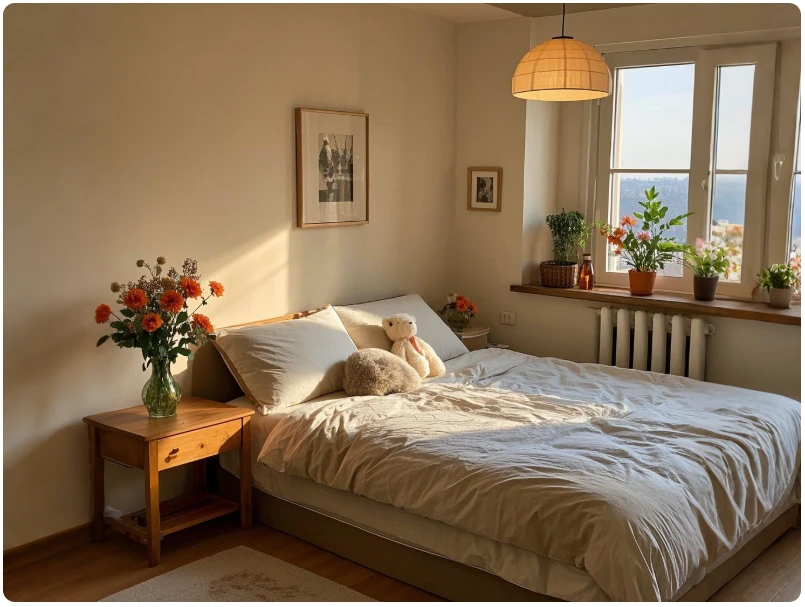
Why a Sleep-Friendly Bedroom Matters
Your sleep environment plays a critical role in the quality of your rest. Even if you have the perfect sleep schedule and follow all the right bedtime habits, an uncomfortable or disruptive bedroom setup can sabotage your sleep. Research has shown that people who sleep in cool, dark, and quiet rooms experience better sleep quality and wake up feeling more refreshed.
Creating a sleep-friendly bedroom means optimizing your environment to help your body and mind relax, fall asleep quickly, and stay asleep throughout the night. If you’ve been struggling with poor sleep or waking up feeling groggy, it may be time to make some adjustments to your bedroom setup.
We also have content about sleep healthhttps://www.fitpeak10.com/index.php/2025/03/11/let-me-sleep-how-to-get-better-rest-and-improve-sleep-quality/
How to Create a Sleep-Friendly Bedroom
Here are some science-backed strategies to transform your bedroom into a sleep sanctuary:
1. Control the Lighting
Light has a direct impact on your circadian rhythm, which regulates your sleep-wake cycle. Excessive light—especially blue light from screens—can delay melatonin production and keep you awake.
- Use blackout curtains – Streetlights and early morning sunlight can disrupt sleep. Installing blackout curtains will create a dark, cozy environment.
- Minimize artificial light – Turn off electronic devices like TVs, smartphones, and computers at least 30–60 minutes before bed.
- Choose warm lighting – Use soft, amber-toned lights instead of harsh white or blue lights. Warm light mimics sunset, signaling to your body that it’s time to wind down.
- Consider a sleep mask – If light from outside or from other rooms is unavoidable, a comfortable sleep mask can help block it out.
2. Keep the Temperature Cool
The ideal room temperature for sleep is between 60–67°F (16–19°C). Your body temperature naturally drops as you prepare for sleep, and a cooler room helps this process along.
- Use breathable bedding – Natural fabrics like cotton, linen, or bamboo wick away moisture and allow airflow, keeping you cool.
- Adjust the thermostat – Set the room temperature to around 65°F (18°C) for the best sleep quality.
- Use a fan or air conditioner – If you can’t control the thermostat, a fan or AC unit can help regulate the temperature and provide soothing white noise.
- Try a cooling mattress topper – If you tend to sleep hot, a cooling gel mattress topper can help prevent overheating.

3. Minimize Noise
Even low levels of noise can disrupt your sleep cycle, leading to lighter sleep stages and more frequent awakenings.
- Use a white noise machine – A steady background noise (like a fan or ocean sounds) can mask sudden or disruptive noises.
- Wear earplugs – Soft foam earplugs can effectively block out environmental noise from traffic or neighbors.
- Soundproof your room – If noise is a consistent problem, consider using soundproof curtains or acoustic panels.
- Turn off electronic sounds – Mute phone notifications and turn off any buzzing or beeping electronics.
4. Invest in a Comfortable Mattress and Pillows
A high-quality mattress and the right pillows are essential for proper spinal alignment and muscle relaxation.
- Choose the right firmness – Side sleepers generally need a softer mattress, while back and stomach sleepers benefit from a firmer surface.
- Replace your mattress regularly – Most mattresses should be replaced every 7–10 years for optimal support and comfort.
- Use supportive pillows – A pillow that keeps your head and neck in alignment with your spine will help prevent pain and stiffness.
- Try memory foam or latex – These materials provide excellent support and pressure relief, helping to reduce tossing and turning.
5. Choose Sleep-Friendly Colors and Décor
The color and design of your bedroom can influence how relaxed you feel when you enter the space.
- Opt for calming colors – Soft, neutral shades like beige, pale blue, and light gray have been shown to promote relaxation.
- Avoid bright or stimulating colors – Red, orange, and neon shades can increase alertness and make it harder to wind down.
- Minimize clutter – A tidy, organized room reduces mental stress and creates a peaceful atmosphere.
- Incorporate natural elements – Plants, wooden furniture, and soft textiles can create a cozy, inviting feel.
6. Remove Electronic Distractions
Electronics are one of the biggest sleep disruptors due to their blue light emission and the mental stimulation they cause.
- Keep the TV out of the bedroom – Watching TV before bed increases alertness and delays sleep onset.
- Use a traditional alarm clock – Checking your phone in the middle of the night can disrupt sleep cycles.
- Enable “Do Not Disturb” mode – Set your phone to silence notifications during sleeping hours.
7. Improve Air Quality
Breathing clean air improves relaxation and reduces nighttime disturbances caused by congestion or discomfort.
- Use an air purifier – This can help remove dust, allergens, and pollutants.
- Open windows during the day – Letting in fresh air can improve oxygen levels and reduce stuffiness.
- Add plants – Plants like lavender, snake plants, and peace lilies naturally purify the air and create a calming atmosphere.
8. Create a Relaxing Pre-Sleep Routine
Setting the right mood before bed helps your mind and body transition into sleep mode.
- Dim the lights 30 minutes before bed – This signals to your brain that it’s time to sleep.
- Try deep breathing or meditation – Relaxation exercises help lower your heart rate and calm your mind.
- Avoid large meals or caffeine close to bedtime – Eating too close to bedtime can disrupt digestion and cause discomfort.
Benefits of a Sleep-Friendly Bedroom
✔️ Improved sleep quality and duration
✔️ Falling asleep faster and waking up less often
✔️ Better mood and emotional balance
✔️ Increased energy and productivity during the day
✔️ Reduced stress and mental fog
Signs Your Sleep Environment Is Working
- You fall asleep within 10–20 minutes of going to bed.
- You wake up feeling refreshed without needing an alarm.
- Your sleep is deep and uninterrupted.
- You no longer feel groggy or fatigued during the day.
To learn more about sleep quality, you can refer to the https://www.health.harvard.edu/diseases-and-conditions/insomnia-a-to-z


